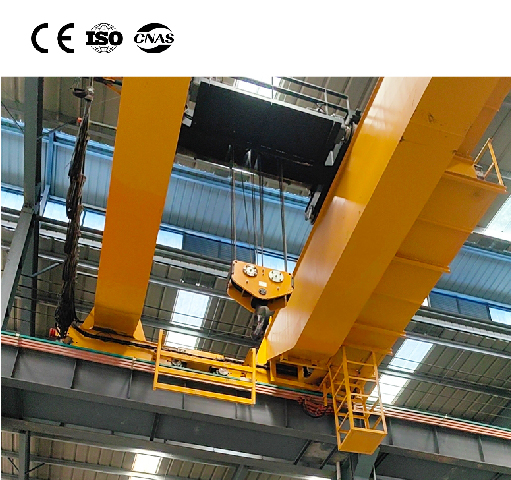When planning industrial lifting operations, one of the most critical questions is: what is the maximum weight that an overhead crane can carry? The answer isn’t a single number but depends on multiple factors including crane type, design, and application. Generally, standard overhead cranes can lift from a few hundred kilograms up to several hundred tons, with specialized systems capable of handling even greater loads.

Understanding the capacity of overhead cranes is essential for ensuring safety, efficiency, and compliance in industrial settings. This comprehensive guide will explore the factors that determine a crane’s maximum lifting capacity, the different types of overhead cranes, and important safety considerations for your operations.
The maximum weight an overhead crane can lift isn’t determined arbitrarily. Several engineering and design factors interact to define this crucial specification:
Structural design: The materials and construction of the bridge girders, end trucks, and runway system fundamentally determine capacity.
Hoist mechanism: The motor, gearbox, brake system, and wire rope or chain design directly impact lifting capabilities.
Support system: The building structure or independent runway support must withstand both the static and dynamic loads.
Power supply: Adequate electrical power is necessary for lifting heavy loads, especially with variable frequency drives.
Control system: Modern systems with precision controls can enhance safety when handling near-maximum loads.
Different overhead crane designs are optimized for varying capacity ranges and applications:
These economical cranes feature a single bridge beam and are typically used for lighter applications. Capacities generally range from 1 to 15 tons, though some heavy-duty models can reach up to 30 tons. They’re ideal for workshops, warehouses, and manufacturing facilities with moderate lifting needs.
With two bridge beams providing enhanced stability, these cranes handle heavier loads. Standard models typically offer capacities from 5 to 100 tons, with specialized designs reaching 300 tons or more. These are common in heavy manufacturing, steel processing, and scrap handling operations.
Similar to bridge cranes but supported by floor-mounted legs instead of overhead runways, gantry cranes can handle capacities comparable to double girder models. They’re particularly useful in outdoor applications like shipyards and container terminals.
For extreme lifting needs, custom-designed cranes can exceed standard capacity ranges. Some examples include:
Double trolley systems: Some configurations like 20t + 20t effectively provide 40-ton capacity through synchronized lifting
Process-specific cranes: For example, those used in concrete pipe pile precast workshops often feature double girder, double trolley designs with capacities ranging from 8t + 8t to 20t + 20t
Different industries have varying overhead crane capacity needs:
| Industry | Typical Applications | Capacity Range |
|---|---|---|
| Manufacturing | Machine handling, assembly | 1-20 tons |
| Warehousing | Material handling, storage | 2-10 tons |
| Steel Service Centers | Coil handling, processing | 10-30 tons |
| Concrete Precasting | Handling forms, rebar cages | 16-40+ tons |
| Power Generation | Turbine maintenance, component replacement | 50-400+ tons |
| Shipbuilding | Section handling, component assembly | 100-800+ tons |
Operating overhead cranes near their maximum capacity requires strict adherence to safety protocols:
Most safety standards require cranes to have a built-in safety factor beyond their rated capacity. However, you should never exceed the published rated capacity without proper engineering evaluation.
Lifting moving, swinging, or irregularly shaped loads creates additional stresses that effectively increase the load on the crane system. For this reason, many operations limit lifts to 80-90% of rated capacity to account for dynamic effects.
Cranes operating frequently near their capacity limits require more rigorous inspection and maintenance schedules. This includes:
Regular structural inspections for deformation or cracking
Frequent hoist mechanism checks (brakes, wire rope, hooks)
Verification of limit switches and overload protection devices
Runway and rail alignment verification
When using two cranes to lift a single load (tandem lifting), special precautions are necessary. Industry standards typically specify that the total load should not exceed 75% of the combined rated capacity of both cranes. This reduced percentage accounts for the potential unequal load distribution between the two cranes.
Selecting the appropriate crane capacity involves more than just matching your heaviest load:
Assess your heaviest anticipated load – Consider both current and future needs
Account for lifting attachments – Hooks, magnets, grabs, and other devices add weight
Consider load dynamics – Shock loads from starting, stopping, or load swinging increase stress
Evaluate frequency of heavy lifts – Occasional heavy lifts might justify rental rather than purchase
Plan for future needs – Consider potential increases in capacity requirements over the crane’s lifespan
A common practice is to select a crane with 25-30% more capacity than your current heaviest load to accommodate future needs and provide an additional safety margin.
Recent innovations in crane technology have both increased maximum capacities and enhanced safety when operating near those limits:
Advanced materials: High-strength steel alloys and aluminum composites allow stronger yet lighter crane structures
Precision controls: Variable frequency drives provide smoother acceleration and deceleration, reducing dynamic loads
Smart monitoring systems: IoT sensors can monitor load weight, structural stresses, and equipment health in real-time
Automated safety systems: Modern systems can prevent overloads through automatic shutdown and alert features
While technical specifications indicate that overhead cranes can carry up to several hundred tons in specialized applications, most industrial facilities find that cranes in the 5 to 20-ton range meet their regular needs. The maximum weight an overhead crane can carry depends on its specific design, configuration, and operating conditions.
When selecting an overhead crane, prioritize a system that not only meets your current capacity requirements but also incorporates appropriate safety margins and potential for future expansion. Remember that safe operation requires not just adequate capacity ratings but also proper installation, maintenance, and trained personnel. By understanding the factors that influence lifting capacity and following established safety guidelines, you can ensure efficient and safe material handling operations in your facility.